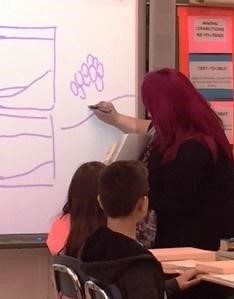
How does geography affect an ecosystem? Recently, South Huntington Grade 5 teachers invited visual artist Beth Giacummo to explore this question with students. The teachers and teaching artist collaborated on a project that integrated mixed media art into the classroom science curriculum in order to understand Long Island geography and how it impacts the local ecosystem.
In the first of six sessions, Ms. Giacummo described the project. She told the students that they would be creating mixed media, bas-relief collages of Long Island’s ecosystem. The fifth graders would be applying what they had learn about Long Island’s geography and its effect on the ecosystem to their collages.
Prior to meeting their first session with the teaching artists, the students visited the Heckscher Museum of Art and saw an exhibit entitled Ebb & Flow: Seascapes and Shoreline Views. Ms. Giacummo guided the students in a discussion about the artwork at the museum. They considered how the artwork was created—for example, either on location or from photographs—as well as some of the artistic considerations, including the horizon line, visual textures, organic versus geometric shapes, and color palette.

Next, Ms. Giacummo described how her own artwork is often inspired by the water. She shared photos of her blown glass creations depicting marine animals. She also reported that her creations are often the results of a team effort with her sister, a marine biologist. Next, she asked the children about their own seashore experiences. “My goal was to make this project relatable to students,” she noted. “I asked the children: ‘How many of you have eaten lobster or mussels?’ The students were eager to share their stories about the water and sea life.”
The teaching artist presented a sample of a finished bas-relief collage representing the Long ecosystem (photo above). She explained the creative process, including materials and the use of color. The students were told they would draw before they started painting. “We talked about the horizon line and how it would need to be high to create an underwater seascape.”

Ms. Giacummo showed the students photographs of sea life. Students identify puffer fish and a seahorse. The teaching artist pointed out eelgrass and mussels. “I also introduced red beard sponge, which would provide color for the composition.” Using the photographs as reference, the students begin to sketch. Ms. Giacummo demonstrated different techniques, such as placement of the horizon line and landscape format, on the whiteboard. The classroom teachers support the artist’s demonstration by reminding the students of their classroom work and the specific land characteristics of Long Island. The teaching artist discussed landforms on the ocean’s floor and how they could create depth by overlapping landforms. She also illustrated how to create mussels beds and eelgrass.

In Session 2, Ms. Giacummo’s sister, a marine biologist at the Cornell Cooperative Extension for Marine Biology, visited the classes. She brought marine life specimens (ie, bivalves, hermit crabs, star fish and spider crab) and set up a touch tank. This hands-on experience prepared the students for sculpting a spider crab with texture using model magic and tempera paint. The teacher guided the students in the creation of the spiders, which were hollow for adhering to the collage.

Using their sketches from Session 1, the students drew and painted a landscape on cradle board. They created a foreground, middle ground, and background. Next, the artist guides them in the drawing of red beard sponge, mussel beds, eel grass. Ms. Giacummo revisited an early lesson on color palette. “I showed them realistic color palettes, and how to mix color and layer paint.” She also tackled brush strokes and painting techniques.
After gluing the painted spider crabs to their cradleboard, the students adhered seahorse and puffer fish to their collages. “Some students wanted to add various sea life to their composition, creatures they’d seen in movies and so forth. I had to remind them that they were creating a Long Island ecosystem and those creatures were not found on Long Island.”

For the culminating activity, the students presented their collages using geography and science terms to explain local geography and how it affects the ecosystem.
